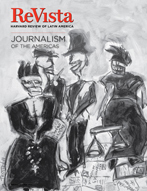WASHINGTON, DC, 8 April 2001 — Many congratulations to June Carolyn Erlick’s latest edition of Harvard’s ReVista Magazine. Titled, “Journalism of the Americas,” the most recent edition is a treasure chest of useful information. I’m sharing the hard copies she sent me with students in my Foreign Correspondence class, as a number of them aspire to work as correspondents in Latin America and the Caribbean. In class next week, we’ll discuss the magazine and its coverage of the changing craft. The class is made up of both undergraduate and graduate students.
As I told June, it is heartbreaking to watch the insatiable quest for profit of U.S. media outlets that have abandoned their social responsibility to provide Americans with the information we need to make critical decisions about our lives and the life of our country. As too many of the mainstream media — and there are notable exceptions — fail their social responsibilities, others are stepping into that void.
My class recently hosted a former student who now works for Al Jazeera English in Washington, DC. He spent about an hour talking about how his outlet is trying to engage more American viewers on television — but mostly online. As we all witnessed during Al Jazeera’s outstanding coverage of the crises rolling across northern Africa and the Middle East, Al Jazeera is eclipsing U.S. news outlets and becoming THE place to go for serious, comprehensive and reliable coverage of some of the major issues of our time.
Just last week the National Press Club hosted the “Al-Jazeera and Global Jihad Conference.” Organizers of the conference aim to convince Americans that the network constitutes a threat against U.S. national security. In a campaign to “Stop Al-Jazeera’s Expansion in the United States” the sponsors, either not understanding or simply not caring that the free flow of information is every Americans’ constitutional right, urge Americans to “fight this scourge.”
And here’s where backpack video journalism come in. For the first time in the history of mankind, the average American can now communicate instantly, globally, and in a language that every person can understand: the visual language. Now, properly trained visual journalists can participate in this national and international conversation that we refer to as “journalism.” So today the people with the talent, the skill and the heart can participate in this conversation, not just the people with corporate support.
— Bill Gentile

